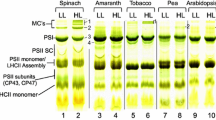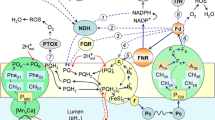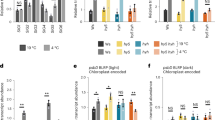Abstract
Steady-state mRNA levels for thylakoid proteins were analysed in spinach cotyledons under diurnally changing light conditions. Most fluctuate considerably throughout the day, while the levels of others show only low amplitude or no oscillation. Levels of mRNAs coding for proteins that belong to the same multiprotein complex generally oscillate in parallel and exhibit maxima that are specific for that complex: mRNAs for photosystem I proteins appear prior to those for photosystem II polypeptides and these again prior to mRNAs for the three polypeptides constituting the oxygen-evolving complex. For the mRNAs that change with high amplitudes (e.g. those for LHCP or the 20 kDa apoprotein of the CP24 complex) oscillations have also been found under constant conditions, indicating that a circadian oscillator is involved. Transgenic tobacco seedlings harbouring chimeric GUS gene fusions with 5′-flanking sequences from the spinach genes Lhcb, PsaF and AtpD (encoding a light-harvesting chlorophyll a/b apoprotein of photosystem II, subunit 3 of photosystem I and subunit δ of the plastid ATP synthase, respectively) confirm that the differences in the amplitudes as well as the timepoints of maximum mRNA accumulation are perceived via cis-regulatory elements upstream of the respective ATG codons.
Similar content being viewed by others
References
Adamska I, Scheel B, Kloppstech K (1991) Circadian oscillations of nuclear-encoded chloroplast proteins in pea (Pisum sativum). Plant Mol Biol 17:1055–1065
Ahmad M, Cashmore AR (1993) HY4 gene of A. thaliana encodes a protein with characteristics of a blue-light photoreceptor. Nature 366:162–166
Apel K, Kloppstech K (1978) The plastid membranes of barley (Hordeum vulgare). Light-induced appearance of mRNA coding for the apoprotein of the light-harvesting chlorophyll a/b protein. Eur J Biochem 85:581–588
Baker NR, Leech RM (1977) Development of photosystem I and photosystem 11 activities in leaves of light grown maize (Zea mays). Plant Physiol 60:640–644
Barkardottir RB, Jensen BE, Kreiberg JD, Nielsen PS, Gausing K (1987) Expression of selected nuclear genes during leaf development in barley. Dev Genet 8:495–511
Bichler J, Herrmann RG (1990) Analysis of the promoters of the single-copy genes for plastocyanin and subunit delta of the chloroplast ATP synthase from spinach. Eur J Biochem 190:415–426
Bolle C, Kusnetsov V, Michl D, Cai D, Klösgen RB, Oelmüller R, Herrmann RG (1992) The genes for the three nuclear-coded subunits of chloroplast ATP synthases: characterization of the promoters from the single-copy genes atpC and atpD from spinach. In: Murata N (ed) Research in photosynthesis, vol III. Kluwer Academic Publishers, Dordrecht Boston London, pp 377–380
Bolle C, Sopory S, Lübberstedt T, Herrmann RG, Oelmiiller R (1994) Segments encoding 5′-untranslated leaders of genes for thylakoid proteins contain cis-elements essential for transcription. Plant J 6:513–523
Bünning E (1973) The physiological clock. Springer, Berlin New York
Bünsow R (1953) Endogene Tagesrhythmik und Photoperiodismus bei Kalanchoe blossfeldiana. Planta 42:220–252
Carter PJ, Nimmo HG, Fewson CA, Wilkins MB (1991) Circadian rhythms in the activity of a plant protein kinase. EMBO J 10:2063–2068
Chappell J, Hahlbrock K (1984) Transcription of plant defence genes in response to UV light or fungal elicitor. Nature 311:67–73
Deng MD, Moureaux T, Leydecker MT, Caboche M (1990) Nitrate-reductase gene expression is under the control of a circadian rhythm and is light-inducible in Nicotiana tabacum leaves. Planta 180:257–261
Feinberg AP, Vogelstein B (1983) A technique for radiolabeling DNA restriction endonuclease fragments to high specific activity. Anal Biochem 132:6–13
Flieger K, Tyagi A, Sopory S, Cseplö A, Herrmann RG, Oelmül-ler R (1993) A 42 base pair promoter fragment of the gene for subunit III of photosystem I (psaF) is crucial for its activity. Plant J 4:9–18
Flieger K, Wicke A, Herrmann RG, Oelmüller R (1994) Promoter and leader sequences of the spinach PsaD and PsaF genes direct an opposite light response in tobacco cotyledons. PsaD sequences downstream of the ATG codon are required for a positive light response. Plant J 6:359–368
Furuya M (1993) Phytochromes: their molecular species, gene families and function. Annu Rev Plant Physiol Plant Mol Biol 44:617–646
Gallagher S, Short TW, Ray PM, Pratt LE, Briggs WR (1988) Light-mediated changes in two proteins associated with plasmena membrane fractions from pea stem sections. Proc Natl Acad Sci USA 85:8003–8007
Giuliano G, Hoffman NE, Ko K, Scolnik PA, Cashmore AR (1988) A light-entrained circadian clock controls transcription of several plant genes. EMBO J 7:3635–3642
Hennessey TL, Field CB (1992) Circadian rhythms in photosynthesis — oscillations in carbon assimilation and stomatal conductance under constant conditions. Plant Physiol 96:831–836
Herrmann RG, Westhoff P, Alt J, Tittgen J, Nelson N (1985) Thylakoid membrane proteins and their genes. In: van Vloten-Doting L, Grott GSP, Hall TL (eds) Molecular form and function of the plant genome. Plenum Press, New York, pp 411–427
Herrmann RG, Oelmüller R, Bichler J, Schneiderbauer A, Steppuhn J, Wedel N, Tyagi AK, Westhoff P (1991) The thylakoid membrane of higher plants: genes, their expression and interaction. In: Herrmann RG, Larkins BA (eds) Plant molecular biology, vol 2. Plenum Press, New York, pp 411–427
Herrmann RG, Westhoff P, Link G (1992) Biogenesis of plastids in higher plants. In: Herrmann RG (ed) Plant gene research, vol 6, cell organelles. Springer, Wien New York
Kaufman LS, Briggs WR, Thompson WF (1985) Different red light requirements for phytochrome induced accumulation of cab RNA and rbcS RNA. Plant Physiol 78:388–393
Kay SA, Millar AJ (1992) Circadian regulated Cab gene transcription in higher plants. In: Young M (ed) The molecular of circadian rhythms. Marcel Dekker, New York, pp 73–89
Kendrick RE, Kronenberg GHM (1994) Photomorphogenesis in plants. Kluwer Academic Publishers, Dordrecht Boston London
Kloppstech K (1985) Diurnal and circadian rhythmicity in the expression of light-induced plant nuclear mRNAs. Planta 165:502–506
Kloppstech K, Meyer G, Bartsch K, Hundrieser J, Link G (1984) Control of gene expression during the early phase of chloroplast development. In: Wiessner W, Robinson DG, Starr RC (eds) Compartments in algal cells and their interaction. Springer, Heidelberg, pp 36–46
Logemann J, Schell J, Willmitzer L (1987) Improved method for the isolation of RNA from plant tissues. Anal Biochem 163:16–20
Millar AJ, Kay SA (1991) Circadian control of cab gene transcription and mRNA accumulation in Arabidopsis. Plant Cell 3:541–550
Millar AJ, Short SR, Chua N-H, Kay SA (1992) A novel circadian phenotype based on firefly luciferase expression in transgenic plants. Plant Cell 4:1075–1087
Nagy F, Kay SA, Chua N-H (1988) A circadian clock regulates transcription of the wheat Cab-1 gene. Genes Dev 2:376–382
Oelmüller R, Lübberstedt T, Bolle C, Sopory S, Tyagi A, Cseplö A, Flieger K, Herrmann RG (1992) Promoter architecture of nuclear genes for thylakoid membrane proteins from spinach. In: Murata N (ed) Research in photosynthesis, vol III. Kluwer Academic Publishers, Dordrecht, pp 219–224
Oelmüller R, Bolle C, Tyagi AK, Niekrawietz N, Breit S, Herrmann RG (1993) Characterization of the promoter from the single-copy gene encoding ferredoxin-NADP+-oxidoreduc-tase from spinach. Mol Gen Genet 237:261–272
Otto B, Grimm B, Ottersbach P, Kloppstech K (1988) Diurnal and circadian control in the control of light- and heat-inducible chloroplast proteins in pea (Pisum satiuum). Plant Physiol 88:21–25
Paulsen H, Bogorad L (1988) Diurnal and circadian rhythms in the accumulation and synthesis of mRNA for the light-harvesting chlorophyll a/b protein in tobacco. Plant Physiol 88:1104–1109
Picchulla B, Gruissem W (1987) Diurnal mRNA fluctuations of nuclear and plastid genes in developing tomato fruits. EMBO J 6:3593–3599
Quail PH (1991) Phytochrome: a light-activated molecular switch that regulates plant gene expression. Annu Rev Genet 25:389–409
Sachs J (1857) Über das Bewegungsorgan und die periodische Bewegung der Blätter von Phaseolus und Oxalis. Bot Z 15:809–815
Satter RL, Geballe GT, Applewhite PB, Galston AW (1974) Potassium flux and leaf movement in Samanea saman. I. Rhythmic movement. J Gen Physiol 64:413–430
Shah DM, Hightower RC, Meagher RB (1982) Complete nucleotide sequence from soybean actin gene. Proc Natl Acad Sci USA 79:1022–1026
Tavladoraki P, Kloppstech K, Argyroudi-Akoyunoglou J (1989) Circadian rhythm in the expression of the mRNA coding for the apoprotein of the light-harvesting complex of photosystem II. Plant Physiol 90:665–672
Taylor WC (1989) Transcriptional regulation by a circadian rhythm. Plant Cell 1:259–264
Vince-Pruce D (1975) Photoperiodism in plants. McGraw Hill, London
Vince-Prue D (1986) The duration of light and photoperiodic responses. In: Kendrick RE, Kronenberg GHM (eds) Photomorphogenesis in higher plants. Martinus Nijhoff Publishers, Dordrecht, pp 269–305
Wilkins MB (1992) Circadian rhythms — their origin and control. New Phytol 121:347–375
Zanetti G, Merati G (1987) Interaction between photosystem I and ferredoxin. J Biochem 169:143–146
Author information
Authors and Affiliations
Additional information
Communicated by R. Hagemann
Rights and permissions
About this article
Cite this article
Oelmüller, R., Schneiderbauer, A., Herrmann, R.G. et al. The steady-state mRNA levels for thylakoid proteins exhibit coordinate diurnal regulation. Molec. Gen. Genet. 246, 478–484 (1995). https://doi.org/10.1007/BF00290451
Received:
Accepted:
Issue Date:
DOI: https://doi.org/10.1007/BF00290451




